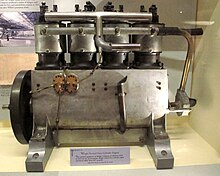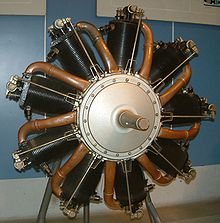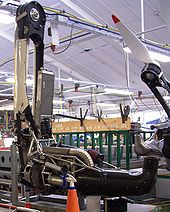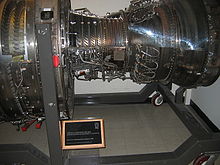Aircraft engine
The greatest advantage of an inline engine is that it allows the aircraft to be designed with a low frontal area to minimize drag.The disadvantages of an inline engine include a poor power-to-weight ratio, because the crankcase and crankshaft are long and thus heavy.Cylinders in this engine are arranged in two in-line banks, typically tilted 60–90 degrees apart from each other and driving a common crankshaft.Due to the cylinder layout, reciprocating forces tend to cancel, resulting in a smooth running engine.In addition, the compact cylinder arrangement reduces the engine's frontal area and allows a streamlined installation that minimizes aerodynamic drag.A radial engine has only one crank throw per row and a relatively small crankcase, resulting in a favorable power-to-weight ratio.In military aircraft designs, the large frontal area of the engine acted as an extra layer of armor for the pilot.Also air-cooled engines, without vulnerable radiators, are slightly less prone to battle damage, and on occasion would continue running even with one or more cylinders shot away.Considerable development of these designs started after World War II, but at the time the aircraft industry favored the use of turbine engines.[13] In modern times the Wankel engine has been used in motor gliders where the compactness, light weight, and smoothness are crucially important.Such conversions first took place in the early 1970s;[citation needed] and as of 10 December 2006 the National Transportation Safety Board has only seven reports of incidents involving aircraft with Mazda engines, and none of these is of a failure due to design or manufacturing flaws.In general, Diesel engines are more reliable and much better suited to running for long periods of time at medium power settings.Yet, civil aircraft designers wanted to benefit from the high power and low maintenance that a gas turbine engine offered.A hybrid system as emergency back-up and for added power in take-off is offered for sale by Axter Aerospace, Madrid, Spain.A turbojet is a type of gas turbine engine that was originally developed for military fighters during World War II.Early designs also respond very slowly to power changes, a fact that killed many experienced pilots when they attempted the transition to jets.A turbofan engine is much the same as a turbojet, but with an enlarged fan at the front that provides thrust in much the same way as a ducted propeller, resulting in improved fuel efficiency.The true advanced technology engine has a triple spool, meaning that instead of having a single drive shaft, there are three, in order that the three sets of blades may revolve at different speeds.Pulsejets are mechanically simple devices that—in a repeating cycle—draw air through a no-return valve at the front of the engine into a combustion chamber and ignite it.Having no moving parts, the engine works by having a coiled pipe in the combustion chamber that superheats the fuel (propane) before being injected into the air-fuel inlet.Induction and compression of the fuel/air mixture is done both by the pressure of propane as it is injected, along with the sound waves created by combustion acting on the intake stacks.Rocket engines are not used for most aircraft as the energy and propellant efficiency is very poor, but have been employed for short bursts of speed and takeoff.[22] For very high supersonic/low hypersonic flight speeds, inserting a cooling system into the air duct of a hydrogen jet engine permits greater fuel injection at high speed and obviates the need for the duct to be made of refractory or actively cooled materials.[citation needed] Refineries blend Avgas with tetraethyllead (TEL) to achieve these high octane ratings, a practice that governments no longer permit for gasoline intended for road vehicles.The shrinking supply of TEL and the possibility of environmental legislation banning its use have made a search for replacement fuels for general aviation aircraft a priority for pilots’ organizations.













Aero-engined carRolls-Royce MerlinAvro YorkShaft enginespropellersrotorsducted fanspropfansInternal thermal enginesPiston engineDiesel engineWankel engineTurbinesTurbopropTurboshaftExternal thermal enginesSteam powerElectric motorsElectric aircraftClockworkHuman-poweredReaction enginesTurbojetTurbofanPropfanRocket-poweredAir turborocketAir-augmented rocketMotorjetPulsejetValveless pulsejetGluhareff Pressure JetAerospike enginePulse detonation engineRotating detonation engineRamjetScramjetShcramjetaircraftpropulsion systempiston enginesgas turbinesrocket poweredList of aircraft enginesPratt & WhitneyRaytheon TechnologiesGeneral ElectricRolls-RoyceCFM InternationalSafran Aircraft EnginesUnited Engine CorporationAviadvigatelKlimovAeroengine Corporation of Chinageneral aviationTimeline of jet powerJohn StringfellowCharlie Taylorinline engineWright FlyerManly-Balzer engineradial enginesLéon LevavasseurV8 engineRené Lorinramjet engineLouis SeguinGnome Omegarotary engineFarman IIIGrande Semaine d'AviationCoandă-1910ducted fanAuguste RateauturbochargerMercedes D.VIW-18 typeIdfliegImperial GermanLuftstreitkräfteZeppelin-Staaken R.VIMercedes D.IIMercedes D.IVaSanford Alexander MossArmstrong Siddeley Jaguarcentrifugal superchargerFrank Whittleturbojet engineHeinkel He 176Heinkel HeS 3Heinkel He 178Jendrassik Cs-1Daimler-Benz DB 670Messerschmitt Me 163Gloster MeteorRolls-Royce TrentBell X-1Turbomeca ArtousteLeduc 010Rolls-Royce ConwayGeneral Electric TF39high bypass turbofanHyShotNASA X-43Pipistrel Velis Electroreciprocating engineStraight engineFairchild PT-19in aviation terms, the phrase "inline engine" also covers V-type and opposed enginespower-to-weight ratioX-enginesU-enginesH-enginesInline engine (aeronautics)V engineSpitfiresBattle of BritainFlat engineULPower ULairplaneshelicoptersturbine enginesH enginePratt & Whitney R-2800Radial enginecrankcase